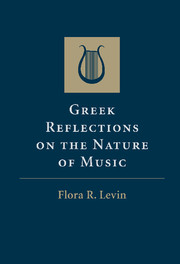Book contents
- Frontmatter
- Contents
- Figures
- Preface
- Introduction
- Abbreviations
- Texts
- 1 All Deep Things Are Song
- 2 We Are All Aristoxenians
- 3 The Discrete and the Continuous
- 4 Magnitudes and Multitudes
- 5 The Topology of Melody
- 6 Aristoxenus of Tarentum and Ptolemaïs of Cyrene
- 7 Aisthēsis and Logos: A Single Continent
- 8 The Infinite and the Infinitesimal
- ΣΦPAΓIΣ
- Bibliography
- Index
5 - The Topology of Melody
Published online by Cambridge University Press: 21 October 2009
- Frontmatter
- Contents
- Figures
- Preface
- Introduction
- Abbreviations
- Texts
- 1 All Deep Things Are Song
- 2 We Are All Aristoxenians
- 3 The Discrete and the Continuous
- 4 Magnitudes and Multitudes
- 5 The Topology of Melody
- 6 Aristoxenus of Tarentum and Ptolemaïs of Cyrene
- 7 Aisthēsis and Logos: A Single Continent
- 8 The Infinite and the Infinitesimal
- ΣΦPAΓIΣ
- Bibliography
- Index
Summary
A solution was still to seek.
Jane Austenmusic seems always to have provided philosophers, physicists, and cosmologists with an ideal image of the universe in action. To Pythagoras, the whole cosmos was a musical domain, the moving planets acting as the physical surrogates of musical notes, the spaces between these notes defined by harmonic boundaries indelibly etched in the fabric of the heavens. The musical space in this domain was in no sense understood as metaphorical; on the contrary, it was perceived to be as real as the movements of the planets themselves. In a giant leap from earth to heaven, Plato made of these planetary notes and the spaces between them a mathematically realized diatonic scale covering four octaves and a major sixth. This, he said, was the work of the Demiurge; and this, his masterpiece, was the World-Soul defined.
With the Demiurge's archetypal scale now fixed to a mathematical certainty, the study of the harmonic truths embedded in this scale had to lead to a direct understanding of the physical structure of the entire universe. Ptolemy applied these truths to astronomy and astrology, thereby wedding his own geocentric planetary system to the numerical ratios determining the musical consonances. As Ptolemy saw it, if the musical consonances are numerical in origin, then the astrological symmetry, because it involves the same numerical ratios as those of the consonances, must itself be a perfect analogue of the musical domain.
The proof of Ptolemy's hypothesis lay in the natural divisions between the constellations of the zodiac that mark the yearly path of the sun through the heavens.
- Type
- Chapter
- Information
- Greek Reflections on the Nature of Music , pp. 154 - 203Publisher: Cambridge University PressPrint publication year: 2009

